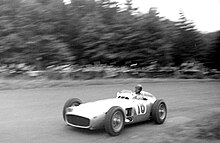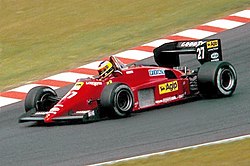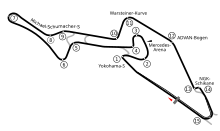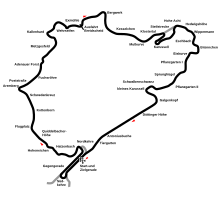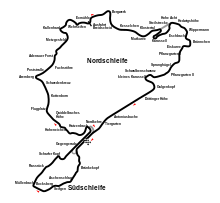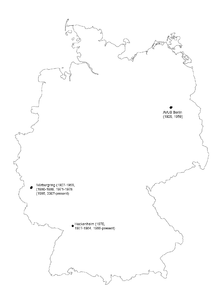German Grand Prix
In 1907, Germany staged the first of the Kaiserpreis (German: Emperor's Prize) races at the 73-mile (118 km) Taunus public road circuit, just outside Frankfurt.
The same circuit had been used three years earlier for the 1904 Gordon Bennett Cup race, which was won by Leon Thery in a Brasier, beating Belgian Camille Jenatzy in a Mercedes.
There was a medical team there, but it took them two and a half hours to get to the site of the accident, of which driver Otto Göbel was badly injured and his co-driver Ludwig Faber, who was pinned under their Adler was already dead.
In the early 1920s, ADAC Eifelrennen races were held on the twisty 33.2 km (20.6 mi) Nideggen public road circuit near Cologne and Bonn.
Sometime around 1925, the construction of a dedicated race track was proposed just south of the Nideggen circuit around the ancient castle of the town of Nürburg, following the examples of Italy's Monza and Targa Florio courses, and Berlin's AVUS, yet with a different character.
This was a huge, incredibly challenging racing circuit that sped and twisted through forests of the Eifel Mountains, and had over 1000 feet (300 m) of elevation change and many spots where the cars visibly left the ground, such as the Flugplatz, Brunnchen and Pflanzgarten sections.
Italian legend Tazio Nuvolari, driving a hopelessly outdated and underpowered Alfa Romeo against state-of-the-art Mercedes and Auto Unions drove a very hard race in appalling conditions.
The 1937 race saw Carraciola win again in a Mercedes and Auto Union driver Ernst Von Delius die after a crash near the Antonius Bridge on the main straight.
Von Delius hit the back of Briton Richard Seaman's Mercedes at 250 km/h (154 mph) and he went flying through a bush and into a field.
The Nordschleife was to be the mainstay of West Germany's premier motor racing event for the next quarter of a century, and was to be known as the toughest and most technically challenging circuit on the F1 calendar.
The 1955 event was cancelled in the aftermath of the Le Mans disaster; all auto racing in Germany (and much of Europe) was banned until the tracks could be upgraded.
A clever tyre choice and skilful driving in wet weather conditions helped Moss to finish 16 seconds in front of von Trips.
Briton John Taylor was killed after he hit the back of Belgian Jacky Ickx's Formula 2 Matra MS5 near the bridge at Quddlebacher and Flugplatz.
Despite considerable pressure from outside parties they voted not to race at the notorious German circuit unless significant changes were made to the track safety conditions of the Nürburgring.
The changes demanded by the drivers were refused by the circuit owners and organizers and could not possibly be made in time for the 1970 event, forcing a hasty switch to the fast Hockenheimring, which had already been upgraded with safety features.
The first event on the rebuilt Nordschleife saw Stewart win from his teammate François Cevert, who battled the Swiss Clay Regazzoni for 2nd with for nearly a quarter of the race.
Briton Ian Ashley crashed his Williams FW during practice at Pflanzgarten and he was seriously injured; he did not race in Formula One again for at least two years.
Briton Tom Pryce ran as high as second after starting 17th in an under-funded Shadow, but he finished fourth after very hot fuel began to leak into his cockpit.
It did not have enough marshals and medical support to ensure the circuit's safety- it needed five to six times the marshals and medical staff that a typical F1 race needed at the time, but Huschke von Hanstein and the German organizers were unwilling and possibly unable to provide them- it was extremely expensive; and the spectators viewing the race in the countryside would get into the track for free.
After pitting to change from wet to dry tyres at the end of the first lap, Lauda came out again, far behind the leader, West German Jochen Mass.
During the impact, Lauda's helmet was wrenched from his head, and his burning Ferrari was hit by the cars of Brett Lunger, Arturo Merzario and Harald Ertl.
Lunger, who had experience with fire during his time in the Vietnam War pulled Lauda out of the burning wreckage instead of the ill-equipped track marshals, who only arrived at the scene well after the impact.
The fast, flat Hockenheim circuit near Heidelberg almost played sole host to the German Grand Prix for the next 30 years.
The 1977 event was won by Lauda, but was also notable when local driver Hans Heyer competed in the race despite failing to qualify.
The 1979 event was one where Swiss Clay Regazzoni in his Williams attempted to chase down his teammate, Australian Alan Jones, but to no avail.
The international motorsports governing body at the time, FISA, had instituted a policy of long-term contracts for one circuit per Grand Prix.
2001 saw a huge accident at the start between Brazilian Luciano Burti in a Prost and Schumacher in a Ferrari; this race was won by Michael's brother Ralf in a BMW-powered Williams.
There was pressure from the FIA and the drivers for Hockenheim to be shortened from the 4.2 mile length circuit which was used as a one off in 1970 and from 1977 to 2001 after the death of Ayrton Senna at Imola in 1994 and later the events of 2000 and 2001.
2004 saw Schumacher continue his domination of that season by winning the German Grand Prix and Spaniard Fernando Alonso won the following year in a Renault after his main rival Kimi Räikkönen suffered a hydraulics failure and retired.
The 2010 GP, held in Hockenheim, at one stage appeared to be in jeopardy as the track owners, the city and the state of Baden-Württemberg, were not willing any more to lose money due to the high licensing costs imposed by F1 management.


